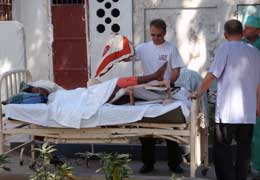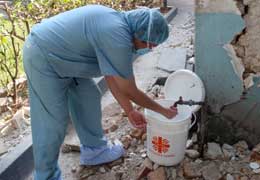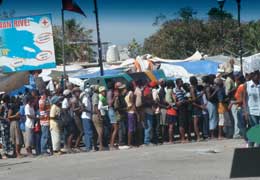Notes on Haiti - CEO Journal Part 2

Note: While serving a medical mission to Haiti, Scripps CEO Chris Van Gorder is writing dispatches about medical aid in progress, conditions on the ground and what can be done to help earthquake victims. For other journal entries, see the Haiti news page.
On Saturday, Jan. 22, Dr. Brent Eastman and I spent the day in Atlanta with the CEO of MedAssets. During the day, we made contact with many physicians in Haiti or physicians who had already been there to plan our mission. We made several contacts in dozens of e-mails and calls during the day. We finally made arrangements with Dr. Edward Gamboa, a former trauma surgeon at Scripps La Jolla, to initially see and possibly work at Hospital Saint Francois de Sales in Port-au-Prince.
Our private aircraft, owned by MedAssets CEO John Bardis, left Atlanta at 10 p.m. Saturday night with an initial destination of Fort Lauderdale, where we picked up six physicians and the CEO of Virginia’s Inova Health System. Mr. Bardis donated his private jet to shuttle physicians and health care personnel back and forth to Haiti for the past several weeks.
The CEO of Inova is Mr. Knox Singleton and his small health system has been supporting a medical mission in Haiti for some time. We arrived in Florida at midnight and met our partners in this mission and took off again at 1:30 a.m. so we could get to Haiti and land in our scheduled time slot at 3 a.m.
Sunday, Jan. 24
Not sure how to even describe today, but I will never forget it either.
Dr. Brent Eastman, our chief medical officer, and I are being hosted by the Vatican Nuncio, the official representative of the Pope to Haiti, so we woke up today in a beautiful facility that overlooks much of Port-au-Prince. As we looked out over the city this morning, we could see a few areas that were badly impacted by the earthquake but, frankly, the view from a distance was actually very pretty. We did see military helicopters flying and large military aircraft from many countries flying in and out of the airport in the distance, so there was a constant reminder of the disaster that hit this country more than a week ago, with many aftershocks since that time.
Dr. Edward Gamboa (former Scripps La Jolla trauma surgeon) helped us make arrangements with the Papal Nuncio for lodging and transportation in Port-au-Prince while we are here.
As we started our day, we observed Sunday Mass being conducted by the Archbishop, our host. The songs from the parishioners were beautiful as they met on the lawn overlooking the city. Even though the sound was beautiful, we had been told that many on the staff and many attending the mass had lost family members to the earthquake. You would not know it from the sound of joyful song. But maybe that is because Haitians have a difficult life. We have been told there are up to 40 percent of Haitians with HIV/AIDs, that up to 52 percent had never attended school, and the average annual salary is about $1300 a year in a country where gasoline is $5 a gallon and food is more expensive than in California. Unemployment is 70 percent and the average life expectancy for a woman is about 57 and a man about 52. Tough lives.
We headed down to the main city in daylight. We arrived in Haiti at about 3 a.m., so we saw little of the city and the damage when we arrived.
The early part of our drive was easy and little damage was seen, but as we entered the flat areas we saw damage that exceeded our expectations. Nothing seen on CNN or FOX news prepares one for the scene of building after building destroyed, or the smell of death still very much in the air. We came upon camp after camp of tent cities, every park and open area was filled with tents and thousands upon thousands of people were walking the streets or standing on the corners. Yes, everyday life was returning — but in a country virtually destroyed by a major earthquake.
After about a half-hour drive, we arrived at the hospital where we were to work today: the Hospital Saint Francois Sales. This hospital was one of the original hospitals in Haiti built in the 1880s, and not upgraded much since.
Large steel gates were opened after our driver honked. I looked around the neighborhood, which was teeming with people, and almost every building had collapsed or sustained major damage. We entered the hospital and I was immediately struck by this sight: all the patients were outside, either in the open on mattresses thrown on the ground or in tents and make-shift tents.
Privacy? No-way. I saw patients literally side-by side in beds, cots, gurneys and chairs. I saw an examination of a woman in the open without any clothes or sheet cover and men and women, boys and girls were all together. Most, if not all, of the injuries were trauma and crush related, and many amputations.
We were met by German and Belgian physicians who had been volunteering at the hospital for several days. Most were leaving in the next few days. The lead Belgian physician (an ED physician) was very direct, but we warmed to him immediately and I think he did to us. He took us on a quick tour. Triage was outside under a canopy — no gurneys, only chairs. The hospital surrounded a courtyard where all patients were in tents or the open; some being attended to by staff or volunteers but most by family members.
Half of the hospital had collapsed. As our guide took us into the building next to the collapsed section, the smell of death was overwhelming. Even Dr. Eastman and I were impacted. Source of the smell: 50 children and adults were under the collapse. Nobody was even thinking, at this point, in trying to recover the bodies. We were told we could operate in the building adjacent to the collapse “if” we could handle the odor. I don’t think so.
The tour continued and we went to the pharmacy, which was now under a collapsed building. Our guide said he could get to the pharmacy by crawling into the building, so he did and I followed. But when we got to the pharmacy, he found the gate locked. He was surprised, but we just climbed back out again. Not much of a search and rescue moment.
The radiology viewing room was outside against a wall, and the one X-ray machine was shut down when the tech said it got too hot. He just left and went home.
Then we were taken to see the patients. Our Belgian physician guide introduced us to some German physicians and we discussed a patient in his late 20s who had received crush injuries to his arm and leg. Dr. Eastman diagnosed a “compartment syndrome,” so our guide said: “Well, take him to surgery,” and we did.
The operating rooms were in a dirty and damaged building — but it appeared safe. There were four areas where surgeries were taking place and three were busy, so we got the large room. Dr. Eastman “scrubbed” at an outside water faucet used normally for attaching a lawn hose.

We put on what surgical gear was available and did the case. While there was an anesthesia machine in the room, it did not work. We only had a pulse oximeter, no blood pressure. No oxygen, as there was only one O2 tank in the entire hospital. No surgical cautery, only medium size gloves, only the Kerlex and 4X4s we brought with us, and Dr. Gamboa brought his own surgical instruments.
While we had a small surgical light, it was insufficient so I pulled out my search and rescue headlamp and put it on Dr. Eastman’s head, which did the trick.
To make a long story short, I think Dr. Eastman saved that man’s arm and leg today. Given the number of amputations at the hospital, they could have used a Dr. Brent Eastman a lot earlier.
Several more cases were done during the day as well as post op care and, at the end of the day, our Belgian guide asked Dr. Eastman to check on a small boy with a crushed foot. Brent operated. He removed much of the dead tissue, amputated a toe, but did the best he could to try to save this boy’s life and foot. And all the while — 30 yards away — 50 dead children and the constant smell of death.
At the end of a long day, we met with the hospital’s director and discussed future days and their needs. On the way home we saw even more destruction: the cathedral — gone; the Ministry of Health — gone; the Haitian Palace — gone; and mile after mile of rubble, collapsed buildings, dust — and people everywhere.
We saw a water/food distribution center where the line of people was hundreds of yards long, and every person was chest to back, no space between anyone in line. That struck me. We drove by the airport and saw many large cargo planes taking off and landing (a huge United Nations presence), traffic jams like I have never seen before and driving that would make a New York cabbie scared to death.

This country has been virtually destroyed and, yet, there are people everywhere and most are acting as if this was just another day. I have never smelled such smells or observed such devastation close up. Yet people acted like it was just another day in Haiti.
Two final stories today: We took our driver’s son to get an X-ray today as a ceiling had fallen on him during the quake and he had been having trouble walking ever since. A friend had given me a small Teddy Bear to pack, to give to an injured child. So I gave the bear to him. The bear was holding a heart that said “hug me.” This little 4-year-old clutched the bear and looked at me and smiled — the first smile I had seen from him. He simply said “merci” as his dad held him as any worried dad would. Given the way he clutched the toy, I suspect that teddy bear will be his friend until he is an adult many years from now.
And one more: When I was working at the hospital today, a little girl grabbed my arm and pulled me into a tent to see her injured sister. I could not understand her and she could not understand me, but I could tell that she wanted me to talk to her sister — or do something for her — so I talked. As I did, I could see her sister relax and, eventually, close her eyes and go to sleep. The girl who had pulled me into the tent just looked at me eye-to-eye and smiled. We did understand each other after all.
Scripps made a difference to a few people in a small foreign country today — and I feel very good about that. Before we left San Diego, we placed an American flag on our Scripps Disaster Team “badges.” Many people saw that today — Scripps and the American flag.
Until tomorrow.
Chris Van Gorder
See the Haiti news page for other journal entries.